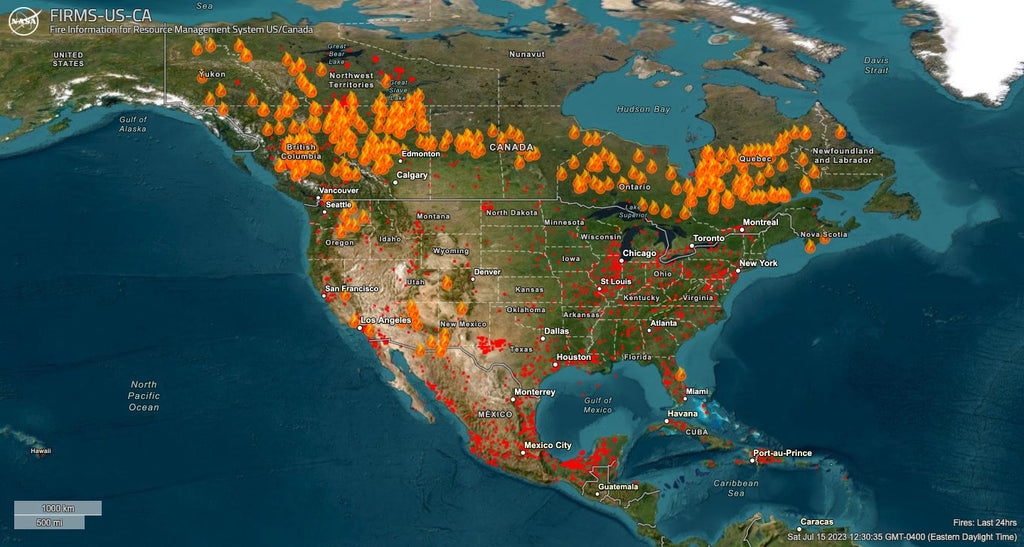
“ [The] 2023 fire season is and will continue to be record-breaking in a number of ways.”
Director General of the Northern Forestry Centre (Canada), Michael Norton
The North-American wildfire season happens once a year; typically lasting from spring to fall. They are caused by high levels of temperature, low levels of humidity and the lack of moisture found in wildfire fuels (trees, shrubs, grass, forest debris, etc.). As climate change becomes a real issue; this “disaster” season has become uncontrollable. The heat wave records in 2023 have already contributed to the damages caused by our wildfire season leading to a record breaking year that has devastating effects for the environment and ultimately, our health.

Nasa Wildfire map from July 15, 2023
Daily updated Nasa Wildfire maps here
2023 Wildfire Season
According to the National Oceanic and Atmospheric Administration (NOAA) “climate change, including increased heat, extended drought, and a thirsty atmosphere, has been a key driver in increasing the risk and extent of wildfires [...] during the last two decades.” This has positioned the 2023 wildfire season the worst ever to date.
As of June 2023 fires became hard to control and almost 2000 uncontrollable fires are burning forests across Canada and the United States. Typically, controlling wildfires during the season costs appx 1 billion dollars every year. Since this year's fires have broken records of intensity, the costs to contain the flames this year will be significantly higher with the number of hectares burnt literally off the charts. Across Canada at this time 8,100,000 hectares had already burned compared to 7,600,000 hectares last year. The flames have caused millions of dollars in damages to homes, businesses and institutions and there are at least three more months left in the active wildfire season. In addition to loss of homes due to flames, the health hazard the wildfire smoke brought to North America forced more than 155 000 people temporarily out of their homes including 4500 Indigenous members that have had to permanently leave their communities.
International Support
Canadian and American officials have declared a “national preparedness level 5” in response to the wildfires. Which means the country will deploy any resources necessary to combat the flames. Even with firefighters and Canadian armed forces on site, “we still need an unprecedented level of international support” to tame the fires, Michael Norton. There is a lack of equipment and resources that canadians possess to control this magnitude which is why the Canadian government has enlisted the voluntary help of 11 countries: South Africa, New Zealand, South Korea, United States, Australia, Costa Rica, Chile and many more willing to share their firefighters and equipment to aid in ceasing the fire. Non profit organizations such as Global Medic and Globalfires are donating whatever equipment they can to facilitate the taming of the flames. Firefighters from these countries have been coming to our aid since June.
Air Quality Issue
Officials caution the population of wildfire smoke as it intensifies everyday, causing significant health risks. In effect North American forest fires in 2023 have emitted the equivalent of the Netherlands annual CO2 footprint. Marie-Eve Heroux, manager of air quality assessment of Health Canada warns to be careful of the “[...] fine particles, the ones that are very small and not visible to the human eye that get deep in the bloodstream.”. She explains that “The smoke [...] is a mix of comprised gases, particles and water vapor that can cause chest pains, coughs and shortness of breath.” That is why breathing it in is considered toxic.” For example, The air quality is so bad and the heat is so heavy in Washington D.C. that the government is urging the population to wear masks outside, opening conditioned spaces with good quality air for the people who can’t afford air conditioning.
The Air Quality Health Index (AQHI), uses an air quality scale with a rating of 1 to 10, with 10 being the worst, a level where people are encouraged to stay indoors. The air quality in Montreal, New York, Washington D.C. reached the level of 10+ this summer and 9 on several days giving us the dubious title of having the world’s worst air quality during this time. Air pollution from the fires have even been carried by winds over to Europe from North America.
What can we do to reverse Climate Change ?
Mother Nature is clearly trying to send us a message; it is time we stop consciously hurting our collective home !
Every small action counts, individuals should incorporate sustainable actions in their everyday routines:
Changing commuting habits where possible using public transport, shared rides and bicycles helps reduce your own carbon footprint.
You can also decrease the amount of energy you use in your home by reducing your habits from water, lighting and electricity usage, as this behavior contributes to a bigger polluting issue.
Choosing organic local foods at the local market helps limit import/export pollution as well as the use of pesticides in farms.
Reducing, reusing and recycling when it comes to consumer products such as fashion, furniture etc
Opening our consumerist minds to welcome renewable energy sources and a circular economy into our lives can only contribute to the much needed healing of our planet.
There are ways one can support for the direct recovery of the 2023 Wildfire season right now through Volunteering and Donation. You can check out more information on these websites;
Canadian Government - Canada Helps - Disaster Philantropy (CDP) - Canadian Red Cross - Direct Relief
Feel free to email contact@bedistudios.com for any questions on this article.
It will be our pleasure to answer!

















